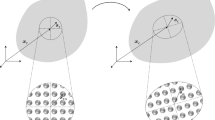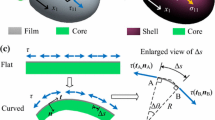Abstract
In the framework of continuum thermodynamics, the present paper presents the thermo-hyperelastic models for both the surface and the bulk of nanostructured materials, in which the residual stresses are taken into account. Due to the existence of residual stresses, different configuration descriptions of the surface (or the bulk) thermo-hyperelastic constitutive equations are not the same even in the cases of infinitesimal deformation. As an example, the effective thermal expansion coefficient of spherical nanoparticles is analyzed.
Similar content being viewed by others
Abbreviations
- 1 :
-
identity tensor in 3D Euclidean space
- A i :
-
covariant base vectors of the reference configuration
- C, C*, Ĉ :
-
Green deformation tensor defined from the reference to the current configurations, from the stress-free to the reference configurations and from the stress-free to the current configurations, respectively
- C sE , C E :
-
surface and bulk specific heat at constant volume
- E, E*, Ê :
-
Green stain tensor defined from the reference to the current configurations, from the stress-free to the reference configurations and from the stress-free to the current configurations, respectively
- E s :
-
surface Green strain tensor
- F, F*, \( \hat F \) :
-
deformation gradient defined from the reference to the current configurations, from the stress-free to the reference configurations and from the stress-free to the current configurations, respectively
- F s , F −1 s :
-
surface deformation gradient and its inverse
- F (o) s , F −1(o) s :
-
out-plane terms of F s and F −1 s
- i :
-
index ranging over the integers 1, 2 and 3
- I 0 :
-
identity tensor on the tangent plane of the surface in the reference configurations
- J, J*:
-
the determinants of F and F*, respectively
- J 1, J 2 :
-
two invariants of the surface right stretch tensor
- k s , k b :
-
surface and bulk thermal conductivities
- L :
-
elasticity tensor defined in the reference configuration
- L 1 :
-
stress-temperature modulus defined in the reference configuration
- P i :
-
covariant base vectors of the stress-free configuration
- q 0 b :
-
heat flows entering the surface from the bulk defined in the reference configurations
- q 0 s , q 0 b :
-
surface and bulk heat fluxes defined in the reference configuration
- \( \hat q_b^R \) R b :
-
initial value of q 0 b
- r 0, \( \bar r \) :
-
radii of nanoparticles in the reference and the stress-free configurations
- r 0 s , r 0 b :
-
surface and bulk heat supply defined in the reference configuration
- S :
-
first kind Piola-Kirchhoff stress
- S s :
-
first kind Piola-Kirchhoff stress of the surface
- T R :
-
bulk residual stress in the reference configuration
- T s :
-
second kind Piola-Kirchhoff stress of the surface
- T s , T b :
-
surface and bulk temperature, respectively
- T 0 s , T 0 b :
-
surface and bulk reference temperature, respectively
- u :
-
displacement measured from the reference configuration
- U s :
-
surface right stretch tensor
- w 0 s :
-
surface free energy per unit area defined in the reference configuration
- α e :
-
effective thermal expansion coefficient of nanoparticles
- β s , β b :
-
surface and bulk coefficients related to thermal expansion
- γ :
-
surface energy per unit area defined in the current configuration
- γ 0*, γ 1*, γ 1 :
-
surface tension, surface Lamé constants
- ɛ 0 s :
-
surface internal energy per unit area defined in the reference configuration
- η 0 s :
-
surface entropy per unit area defined in the reference configurations
- η :
-
bulk entropy per unit volume
- η R :
-
residual value of η in the reference configuration
- λ, μ :
-
bulk Lamé constants
- θ s , θ b :
-
surface and bulk temperature change, respectively
- σ, σ s :
-
Cauchy stress and surface Cauchy stress, respectively
- ∇0, ∇0s :
-
bulk and surface gradient operators defined in the reference configuration
- (∧):
-
quantity defined in the stress-free configuration
References
Hill T L. Thermodynamics of Small Systems. New York: Dover Pub. INC, 2002
Guo Z Y. Frontier of heat transfer—microscale heat transfer (in Chinese). Adv Mech, 2000, 30: 1–6
Cimalla V, Niebelschutz F, Tonisch K, et al. Nanoelectromechanical devices for sensing applications. Sensor Actuat B, 2007, 126: 24–34
Cleland A N. Foundations of Nanomechanics. Berlin: Springer, 2003
Gleiter H. Nanostructured materials: Basic concepts and microstructure. Acta Mater, 2000, 48: 1–29
Bhushan B. Handbook of Nanotechnology. 3rd Ed. Berlin: Springer, 2010
Tang Z, Zhao H, Li G, et al. Finite-temperature quasicontinuum method for multiscale analysis of silicon nanostructures. Phys Rev B, 2006, 74: 064110
Xiao S P, Yang W X. Temperature-related Cauchy-Born rule for multiscale modeling of crystalline solids. Comp Mater Sci, 2006, 37: 374–379
Yang W X, Xiao S P. Extension of the temperature-related Cauchy-Born rule: Material stability analysis and thermo-mechanical coupling. Comp Mater Sci, 2008, 41: 431–439
Yun G, Park H S. A multiscale, finite deformation formulation for surface stress effects on the coupled thermomechanical behavior of nanomaterials. Comput Method Appl Mech Eng, 2008, 197: 3337–3350
Murdoch A I. A thermodynamical theory of elastic material interfaces. Q J Mech Appl Math, 1976, 29: 245–275
Rusanov A. Thermodynamics of solid surfaces. Surf Sci Rep, 1996, 23: 173–247
Javili A, Steinmann P. On thermomechanical solids with boundary structures. Int J Solids Struct, 2010, 47: 3245–3253
Chen T, Dvorak G. Fibrous nanocomposites with interface stress: Hill's and Levin's connections for effective moduli. Appl Phys Lett, 2006, 88: 211912
Duan H L, Karihaloo B L. Thermo-elastic properties of heterogeneous materials with imperfect interfaces: Generalized Levin's formula and Hill's connections. J Mech Phys Solids, 2007, 55: 1036–1052
Gordeliy E, Mogilevskaya S G, Crouch S L. Transient thermal stresses in a medium with a circular cavity with surface effects. Int J Solids Struct, 2009, 46: 1834–1848
Ru C Q. Size effect of dissipative surface stress on quality factor of microbeams. Appl Phys Lett, 2009, 94: 051905
Huang Z P, Wang J. A theory of hyperelasticity of multi-phase media with surface/interface energy effect. Acta Mech, 2006, 182: 195–210
Huang Z P, Sun L. Size-dependent effective properties of a het-erogeneous material with interface energy effect: From finite defor-mation theory to infinitesimal strain analysis. Acta Mech, 2007, 190: 151–163
Wang Z Q, Zhao Y P. Self-instability and bending behaviors of nano plates. Acta Mech Solida Sinica, 2009, 22: 630–643
Wang Z Q, Zhao Y P, Huang Z P. The effects of surface tension on the elastic properties of nano structures. Int J Eng Sci, 2010, 48: 140–150
Ru C Q. Simple geometrical explanation of Gurtin-Murdoch model of surface elasticity with clarification of its related versions. Sci China Phys Mech Astron, 2010, 53: 536–544
Truesdell C, Noll W. The Non-linear Field Theories of Mechanics. Berlin: Springer, 2004
Hwang K C, Huang Y G. Solid Constitutive Relations (in Chinese). Beijing: Tsinghua University Press, 1999
Gurtin M E, Fried E, Anand L. The Mechanics and Thermodynamics of Continua. Cambridge: Cambridge University Press, 2009
Dui G S, Wang Z D, Jin M. Derivatives on the isotropic tensor functions. Sci China Ser G-Phys Mech Astron, 2006, 49: 321–334
Pathak S, Shenoy V B. Size dependence of thermal expansion of nanostructures. Phys Rev B, 2005, 72: 113404
Zhou L J, Guo J G, Zhao Y P. Size and temperature-dependent thermal expansion coefficient of a nanofilm. Chinese Phys Lett, 2009, 26: 06620
Murdoch A I. Some fundamental aspects of surface modeling. J Elast, 2005, 80: 33–52
Author information
Authors and Affiliations
Corresponding author
Rights and permissions
About this article
Cite this article
Wang, Z., Zhao, Y. Thermo-hyperelastic models for nanostructured materials. Sci. China Phys. Mech. Astron. 54, 948–956 (2011). https://doi.org/10.1007/s11433-011-4299-8
Received:
Accepted:
Published:
Issue Date:
DOI: https://doi.org/10.1007/s11433-011-4299-8




